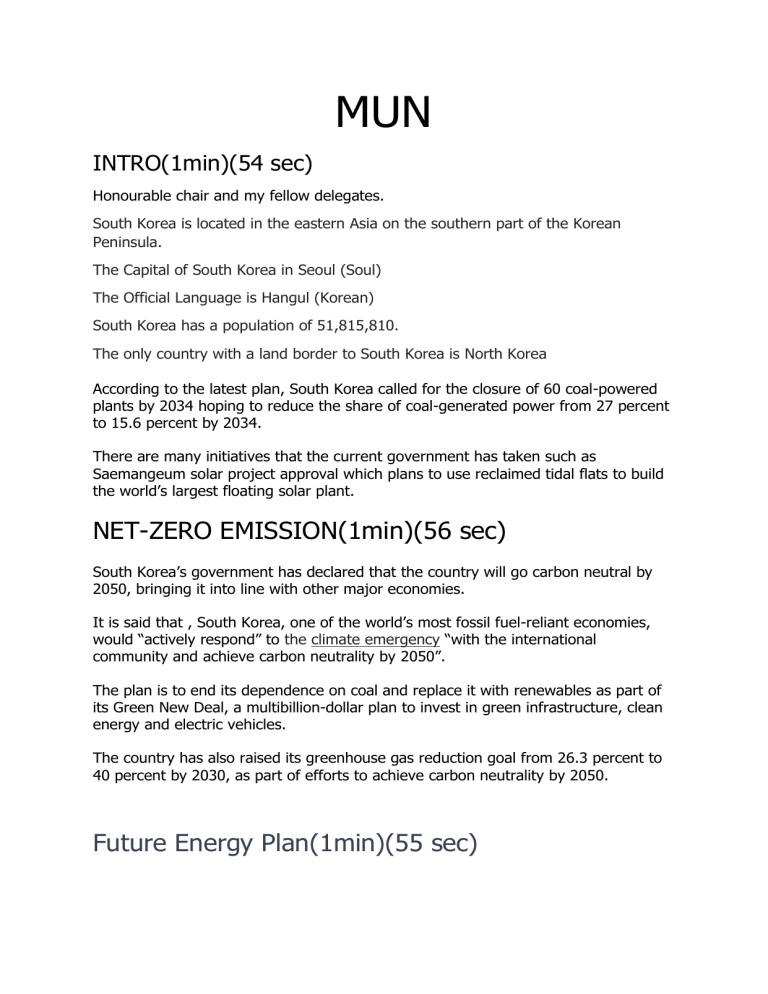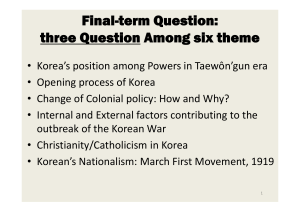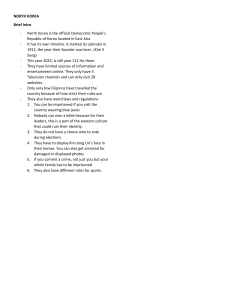MUN
advertisement

MUN INTRO(1min)(54 sec) Honourable chair and my fellow delegates. South Korea is located in the eastern Asia on the southern part of the Korean Peninsula. The Capital of South Korea in Seoul (Soul) The Official Language is Hangul (Korean) South Korea has a population of 51,815,810. The only country with a land border to South Korea is North Korea According to the latest plan, South Korea called for the closure of 60 coal-powered plants by 2034 hoping to reduce the share of coal-generated power from 27 percent to 15.6 percent by 2034. There are many initiatives that the current government has taken such as Saemangeum solar project approval which plans to use reclaimed tidal flats to build the world’s largest floating solar plant. NET-ZERO EMISSION(1min)(56 sec) South Korea’s government has declared that the country will go carbon neutral by 2050, bringing it into line with other major economies. It is said that , South Korea, one of the world’s most fossil fuel-reliant economies, would “actively respond” to the climate emergency “with the international community and achieve carbon neutrality by 2050”. The plan is to end its dependence on coal and replace it with renewables as part of its Green New Deal, a multibillion-dollar plan to invest in green infrastructure, clean energy and electric vehicles. The country has also raised its greenhouse gas reduction goal from 26.3 percent to 40 percent by 2030, as part of efforts to achieve carbon neutrality by 2050. Future Energy Plan(1min)(55 sec) South Korea is vying to win the race to create the first hydrogen society. It wants to build three hydrogen-powered cities by 2022 as it positions itself as a leader in green technology. The plan will see the cities use hydrogen as the fuel for cooling, heating, electricity and transportation. The hydrogen society strategy is part of a wider vision to power 10% of the country's cities, counties and towns with hydrogen by 2030, growing to 30% by 2040. This includes drastic increases in the numbers of hydrogen-powered vehicles and charging points in the next three years. The government has earmarked money to subsidize these vehicles and charging infrastructure. Pros and Cons of Renewable Energy Pro: (30 sec)(30.3 sec) The government’s pledge of a Green New Deal as part of its Covid-19 economic recovery package in July 2020 is a significant step towards accelerating Korea’s energy transition. Achieving the ambitions of the Green New Deal will require addressing regulatory and institutional barriers, introducing more flexible energy markets, and making use of the country’s expertise in advanced technologies and innovative capacity. Cons: (30 sec)(32.49 sec) The country doesn’t have much space on the seabed but the only way we can explore wind energy is to go towards deeper sea and to go to deep sea, we need a floating wind turbine. That technology is not yet matured as, cables, needed to anchor the windmills’ floating platforms, need to withstand the force of a windmill generating a massive amount of energy for 25 years, they also need to be detachable so the platforms and windmills can be taken for inspection. This technology needs to be figured out.



